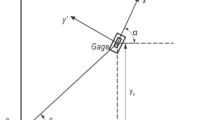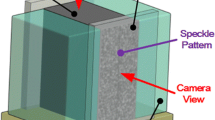Abstract
A non-contact optical method for strain measurement applying three-dimensional digital image correlation (3D DIC) in uniaxial compression is presented. A series of monotonic uniaxial compression tests under quasi-static loading conditions on Hawkesbury sandstone specimens were conducted. A prescribed constant lateral-strain rate to control the applied axial load in a closed-loop system allowed capturing the complete stress–strain behaviour of the rock, i.e. the pre-peak and post-peak stress–strain regimes. 3D DIC uses two digital cameras to acquire images of the undeformed and deformed shape of an object to perform image analysis and provides deformation and motion measurements. Observations showed that 3D DIC provides strains free from bedding error in contrast to strains from LVDT. Erroneous measurements due to the compliance of the compressive machine are also eliminated. Furthermore, by 3D DIC technique relatively large strains developed in the post-peak regime, in particular within localised zones, difficult to capture by bonded strain gauges, can be measured in a straight forward manner. Field of strains and eventual strain localisation in the rock surface were analysed by 3D DIC method, coupled with the respective stress levels in the rock. Field strain development in the rock samples, both in axial and shear strain domains suggested that strain localisation takes place progressively and develops at a lower rate in pre-peak regime. It is accelerated, otherwise, in post-peak regime associated with the increasing rate of strength degradation. The results show that a major failure plane, due to strain localisation, becomes noticeable only long after the peak stress took place. In addition, post-peak stress–strain behaviour was observed to be either in a form of localised strain in a shearing zone or inelastic unloading outside of the shearing zone.













Similar content being viewed by others
Abbreviations
- F :
-
Applied axial load
- t :
-
Time
- q :
-
Differential stress
- q peak :
-
Peak stress
- q cc :
-
Crack closure stress
- q ci :
-
Crack initiation stress
- q cd :
-
Crack damage stress
- \(\varepsilon_{\text{A}}\), \(\varepsilon_{\text{L}}\) :
-
Axial and lateral strains
- \(\varepsilon_{\text{vol}}\) :
-
Volumetric strain
- \(\varepsilon_{\text{vol}}^{\text{e}}\) :
-
Elastic volumetric strain
- \(\varepsilon_{\text{vol}}^{\text{c}}\) :
-
Crack-induced volumetric strain
- \(E\) :
-
Young’s modulus
- \(\upsilon\) :
-
Poisson’s ratio
- \({\text{d}}F / {\text{d}}t\) :
-
Rate of loading
- \({\text{d}}\varepsilon_{\text{A}} / {\text{d}}t\) :
-
Rate of axial strain
- \({\text{d}}\varepsilon_{\text{L}} / {\text{d}}t\) :
-
Rate of lateral strain
- LVDT:
-
Linear variable displacement transducers
- UCS:
-
Unconfined compressive strength
- 3D DIC:
-
Three-dimensional digital image correlation
- CDZ:
-
Compression damage zone
References
Al-Harthi AA (1998) Effect of planar structures on the anisotropy of Ranyah sandstone, Saudi Arabia. Eng Geol 50:49–57. doi:10.1016/S0013-7952(97)00081-1
Amann F, Button E, Evans K, Gischig V, Blümel M (2011) Experimental study of the brittle behavior of clay shale in rapid unconfined compression. Rock Mech Rock Eng 44:415–430. doi:10.1007/s00603-011-0156-3
Bažant Z (1989) Identification of strain softening constitutive relation from uniaxial tests by series coupling model for localisation. Cem Concr Res 19:973–997
Bieniawski ZT, Bernede MJ (1979) Suggested methods for determining the uniaxial compressive strength and deformability of rock materials: Part 1. Suggested method for determination of the uniaxial compressive strength of rock materials. Int J Rock Mech Min Sci Geomech Abstr 16:137. doi:10.1016/0148-9062(79)91450-5
Bischoff PH, Perry SH (1991) Compressive behaviour of concrete at high strain rates. Mater Struct 24:425–450
Chu TC, Ranson WF, Sutton MA (1985) Applications of digital-image-correlation techniques to experimental mechanics. Exp Mech 25:232–244. doi:10.1007/BF02325092
Dautriat J, Bornert M, Gland N, Dimanov A, Raphanel J (2011) Localized deformation induced by heterogeneities in porous carbonate analysed by multi-scale digital image correlation. Tectonophysics 503:100–116. doi:10.1016/j.tecto.2010.09.025
Fairhurst CE, Hudson JA (1999) Draf ISRM suggested method for the complete stress-strain curve for intact rock in uniaxial compression. Int J Rock Mech Min Sci 36:279–289. doi:10.1016/S0148-9062(99)00006-6
Gatelier N, Pellet F, Loret B (2002) Mechanical damage of an anisotropic porous rock in cyclic triaxial tests. Int J Rock Mech Min Sci 39:335–354. doi:10.1016/S1365-1609(02)00029-1
Hallbauer DK, Wagner H, Cook NGW (1973) Some observations concerning the microscopic and mechanical behaviour of quartzite specimens in stiff, triaxial compression tests. Int J Rock Mech Min Sci Geomech Abstr 10:713–726. doi:10.1016/0148-9062(73)90015-6
Hashiba K, Okubo S, Fukui K (2006) A new testing method for investigating the loading rate dependency of peak and residual rock strength. Int J Rock Mech Min Sci 43:894–904. doi:10.1016/j.ijrmms.2005.12.005
Hawkes I, Mellor M (1970) Uniaxial testing in rock mechanics laboratories. Eng Geol 4:179–285. doi:10.1016/0013-7952(70)90034-7
He C, Okubo S, Nishimatsu Y (1990) A study of the class II behaviour of rock. Rock Mech Rock Eng 23:261–273. doi:10.1007/BF01043307
Heinz SR, Wiggins JS (2010) Uniaxial compression analysis of glassy polymer networks using digital image correlation. Polym Testing 29:925–932. doi:10.1016/j.polymertesting.2010.08.001
Hudson JA, Brown ET, Fairhurst C (1971) Optimizing the control of rock failure in servo-controlled laboratory tests. Rock Mech 3:217–224. doi:10.1007/BF01238181
ISRM (1981) Rock characterization testing and monitoring—ISRM suggested methods. Oxford
Jansen DC, Shah S (1997) Effect of length on compressive strain softening of concrete. J Eng Mech 123:25–35. doi:10.1061/(ASCE)0733-9399(1997)123:1(25)
Jansen DC, Shah SP, Edwin CR (1995) Stress-strain results of concrete from circumferential strain feedback control testing. Mater J. doi:10.14359/9774
Markeset G, Hillerborg A (1995) Softening of concrete in compression—localization and size effects. Cem Concr Res 25:702–708. doi:10.1016/0008-8846(95)00059-L
Martin C, Chandler N (1994) The progressive fracture of Lac du Bonnet granite. Int J Rock Mech Min Sci Geomech Abstr, vol 6. Elsevier, pp 643–659
Nguyen TL, Hall SA, Vacher P, Viggiani G (2011) Fracture mechanisms in soft rock: identification and quantification of evolving displacement discontinuities by extended digital image correlation. Tectonophysics 503:117–128. doi:10.1016/j.tecto.2010.09.024
Okubo S, Nishimatsu Y (1985) Uniaxial compression testing using a linear combination of stress and strain as the control variable. Int J Rock Mech Min Sci Geomech Abstr 22:323–330. doi:10.1016/0148-9062(85)92064-9
Okubo S, Nishimatsu Y, He C (1990) Loading rate dependence of class II rock behaviour in uniaxial and triaxial compression tests—an application of a proposed new control method. Int J Rock Mech Min Sci Geomech Abstr 27:559–562. doi:10.1016/0148-9062(90)91007-T
Rummel F, Fairhurst C (1970) Determination of the post-failure behavior of brittle rock using a servo-controlled testing machine. Rock Mech 2:189–204. doi:10.1007/BF01245574
Rust BR, Jones BG (1987) The Hawkesbury Sandstone South of Sydney, Australia: Triassic analogue for the deposit of a large, braided river. J Sedim Petrol 57:222–233
Song H, Zhang H, Kang Y, Huang G, Fu D, Qu C (2013) Damage evolution study of sandstone by cyclic uniaxial test and digital image correlation. Tectonophysics 608:1343–1348. doi:10.1016/j.tecto.2013.06.007
Sutton MA, Orteu JJ, Schreier H (2009) Image correlation for shape, motion and deformation measurements. Springer, USA
Taheri A, Tani K (2008) Use of down-hole triaxial apparatus to estimate the mechanical properties of heterogeneous mudstone. Int J Rock Mech Min Sci 45:1390–1402. doi:10.1016/j.ijrmms.2008.01.017
Tarasov B, Potvin Y (2013) Universal criteria for rock brittleness estimation under triaxial compression. Int J Rock Mech Min Sci 59:57–69. doi:10.1016/j.ijrmms.2012.12.011
Vasconcelos G, Lourenço P, Alves C, Pamplona J (2009) Compressive behavior of granite: experimental approach. J Mater Civ Eng 21:502–511. doi:10.1061/(ASCE)0899-1561(2009)21:9(502)
Wawersik WR, Brace WF (1971) Post-failure behavior of a granite and diabase. Rock Mech 3:61–85. doi:10.1007/BF01239627
Wawersik WR, Fairhurst CA (1970) A study of brittle rock fracture in laboratory compression experiments. Int J Rock Mech Min Sci 7:561–575
Yang G, Cai Z, Zhang X, Fu D (2015) An experimental investigation on the damage of granite under uniaxial tension by using a digital image correlation method. Opt Lasers Eng 73:46–52. doi:10.1016/j.optlaseng.2015.04.004
Zhang H, Huang G, Song H, Kang Y (2012) Experimental investigation of deformation and failure mechanisms in rock under indentation by digital image correlation. Eng Fract Mech 96:667–675. doi:10.1016/j.engfracmech.2012.09.012
Acknowledgments
The work has been supported by the Deep Exploration Technologies Cooperative Research Centre whose activities are funded by the Australian Government’s Cooperative Research Centre Programme. This is DET CRC Document 2015/781.
Author information
Authors and Affiliations
Corresponding author
Rights and permissions
About this article
Cite this article
Munoz, H., Taheri, A. & Chanda, E.K. Pre-Peak and Post-Peak Rock Strain Characteristics During Uniaxial Compression by 3D Digital Image Correlation. Rock Mech Rock Eng 49, 2541–2554 (2016). https://doi.org/10.1007/s00603-016-0935-y
Received:
Accepted:
Published:
Issue Date:
DOI: https://doi.org/10.1007/s00603-016-0935-y




